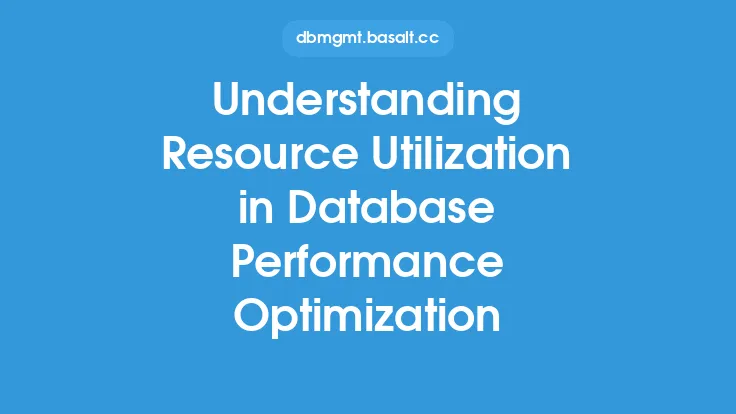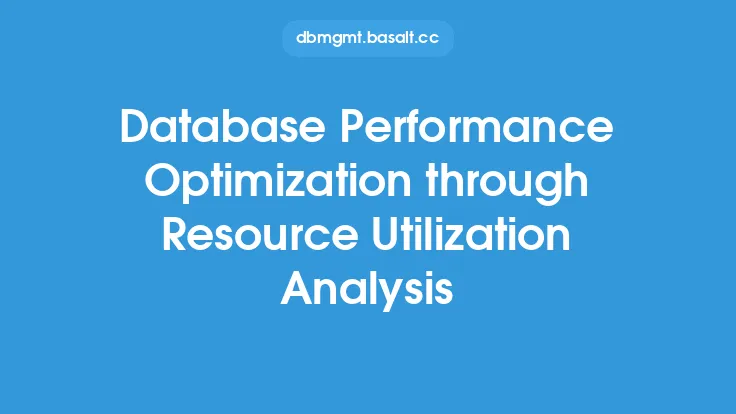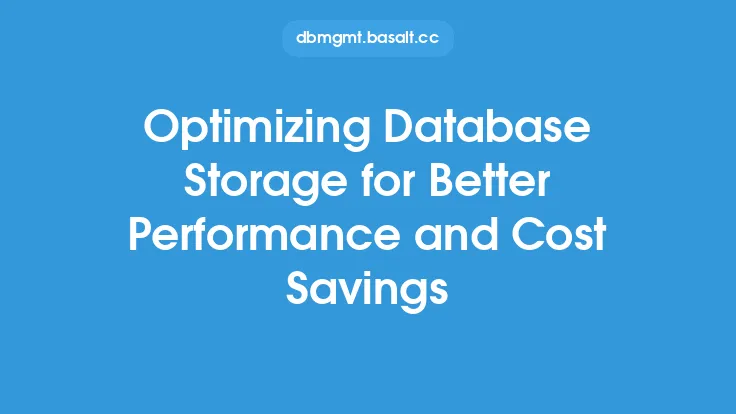When it comes to optimizing database performance, one crucial aspect that is often overlooked is memory allocation. Database memory allocation refers to the process of assigning a portion of the system's RAM to the database management system (DBMS) for use in storing and retrieving data. Proper memory allocation is essential for ensuring that the database can handle a high volume of requests without experiencing performance degradation. In this article, we will delve into the world of database memory allocation, exploring the different types of memory allocation, the factors that affect memory allocation, and the best practices for optimizing database memory allocation for better performance and resource utilization.
Introduction to Database Memory Allocation
Database memory allocation is a critical component of database configuration tuning. The DBMS uses memory to store data, indexes, and other database structures, as well as to perform various operations such as sorting, joining, and aggregating data. The amount of memory allocated to the database can significantly impact its performance, with insufficient memory leading to increased disk I/O, slower query execution, and decreased overall system responsiveness. On the other hand, allocating too much memory to the database can lead to memory starvation, causing other system processes to become unresponsive or even crash.
Types of Database Memory Allocation
There are several types of database memory allocation, each with its own unique characteristics and use cases. The most common types of memory allocation include:
- Shared Memory: Shared memory refers to a pool of memory that is shared among multiple database processes. This type of memory allocation is commonly used in databases that support multiple concurrent connections, such as Oracle and PostgreSQL.
- Private Memory: Private memory, on the other hand, refers to a dedicated pool of memory that is allocated to a single database process. This type of memory allocation is commonly used in databases that support a single connection, such as MySQL.
- Virtual Memory: Virtual memory refers to a combination of physical RAM and disk storage that is used to store database data and structures. This type of memory allocation is commonly used in databases that require large amounts of memory, such as data warehousing and business intelligence applications.
Factors Affecting Database Memory Allocation
Several factors can affect database memory allocation, including:
- Database Size: The size of the database can significantly impact memory allocation, with larger databases requiring more memory to store data and indexes.
- Workload: The type and intensity of the workload can also impact memory allocation, with high-transaction workloads requiring more memory to handle the increased load.
- Database Configuration: Database configuration parameters, such as buffer pool size and sort area size, can also impact memory allocation.
- System Resources: The amount of available system resources, such as RAM and CPU, can also impact memory allocation.
Best Practices for Optimizing Database Memory Allocation
To optimize database memory allocation for better performance and resource utilization, follow these best practices:
- Monitor Database Memory Usage: Monitor database memory usage regularly to identify trends and patterns, and adjust memory allocation accordingly.
- Adjust Buffer Pool Size: Adjust the buffer pool size to optimize memory allocation for the database workload.
- Use Memory-Aware Database Configuration: Use memory-aware database configuration parameters, such as automatic memory management, to optimize memory allocation.
- Avoid Memory Starvation: Avoid memory starvation by ensuring that the database is not allocated too much memory, leaving insufficient memory for other system processes.
- Use Virtual Memory: Use virtual memory to supplement physical RAM and improve database performance.
Tools and Techniques for Optimizing Database Memory Allocation
Several tools and techniques can be used to optimize database memory allocation, including:
- Database Performance Monitoring Tools: Database performance monitoring tools, such as Oracle Enterprise Manager and PostgreSQL pgstatstatements, can be used to monitor database memory usage and identify trends and patterns.
- Memory Profiling Tools: Memory profiling tools, such as Valgrind and Java VisualVM, can be used to analyze database memory usage and identify memory leaks and other issues.
- Database Configuration Tuning Tools: Database configuration tuning tools, such as Oracle's Database Configuration Assistant and PostgreSQL's pg_tune, can be used to optimize database configuration parameters and improve memory allocation.
Conclusion
Optimizing database memory allocation is a critical component of database performance optimization. By understanding the different types of memory allocation, the factors that affect memory allocation, and the best practices for optimizing database memory allocation, database administrators can improve database performance, reduce resource utilization, and ensure that the database is running at optimal levels. Whether you are using a relational database management system like Oracle or PostgreSQL, or a NoSQL database like MongoDB or Cassandra, optimizing database memory allocation is essential for ensuring that your database is performing at its best.





